Inside The New York Botanical Garden
beekeeping
Posted in Around the Garden on October 7 2019, by Ann Novak
Annie Novak is the Manager of the Edible Academy at The New York Botanical Garden.
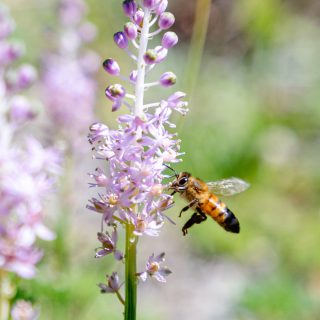 We introduced our first pair of beehives to the Ruth Rea Howell Family Garden in 2010, the year beekeeping was re-legalized in New York City. We sited the apiaries—Langstroth hives—atop the single flat rooftop on our garden site, a one-story brick and concrete building home to both gardening and office equipment fondly called “the tool shed.” This gave our foraging worker bees zipping in and out of the hive a clear flight path above our vegetable plots, above and away from our visitors.
We introduced our first pair of beehives to the Ruth Rea Howell Family Garden in 2010, the year beekeeping was re-legalized in New York City. We sited the apiaries—Langstroth hives—atop the single flat rooftop on our garden site, a one-story brick and concrete building home to both gardening and office equipment fondly called “the tool shed.” This gave our foraging worker bees zipping in and out of the hive a clear flight path above our vegetable plots, above and away from our visitors.
With the opening of the Edible Academy campus in the spring of 2018, our beehives moved to a much better location: the Kate Solomon Family Apiary, a flat, staff-accessible platform adjacent to the Gossett Overlook Pavilion. Now at eye-level (at a safe distance), visitors can observe the honeybees more readily. Unsurprisingly, a frequent query is what we do with their honey.
Read More
Posted in Programs and Events on September 5 2012, by Matt Newman
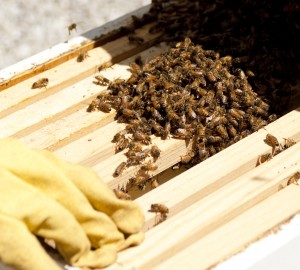 So you don’t have a back yard, a rooftop apartment in Brooklyn, or even a couple of bee suits and a smoking can. Not a problem! For kids (or parents!) who are bursting with questions over the city’s biggest agricultural excitement since fire escapes first met tomato plants, you won’t need any of the above to pick up the basics.
So you don’t have a back yard, a rooftop apartment in Brooklyn, or even a couple of bee suits and a smoking can. Not a problem! For kids (or parents!) who are bursting with questions over the city’s biggest agricultural excitement since fire escapes first met tomato plants, you won’t need any of the above to pick up the basics.
While the Ruth Rea Howell Family Garden is home to two active beehives, Assistant Manager Annie Novak and her team have put together the full beekeeping kit–sans bugs–for those who’d rather go to the open house without the tenants in attendance, so to speak. Apiculture at its easiest! And we won’t be sparing with the sweets, either; if you’ve ever wondered how flower choice affects what goes into the jar, we’ll be offering tastes of the many different types of honey that a healthy hive can produce.
Read More
Posted in Photography on August 16 2012, by Ann Rafalko
A good Thursday morning to you from the beehives above the Ruth Rea Howell Family Garden!
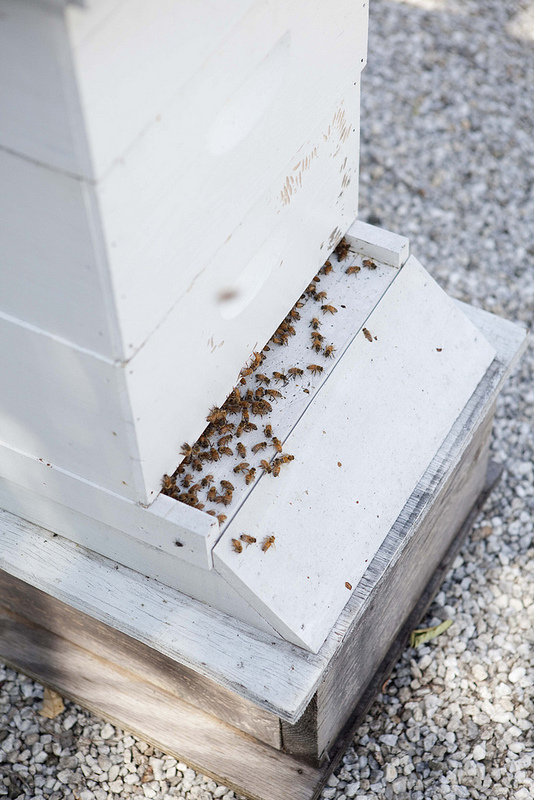
Photo by Ivo M. Vermeulen
Posted in Around the Garden on May 8 2012, by Ann Novak
Ed. Note: The beekeeping craze that’s sweeping New York City isn’t just for rooftops in Brooklyn! Annie Novak, Assistant Manager of the Ruth Rea Howell Family Garden, was kind enough to explain her most recent adventure giving bees a home at the NYBG.
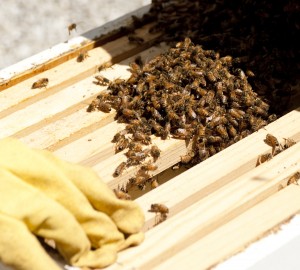 We installed the beehives on top of our garden shed space, so the bees have a clear flight path over the Garden site. As the hives’ populations grow, so do our vegetables. Thanks to the bees, we have higher rates of fruiting on our apple trees and pepper plants.
We installed the beehives on top of our garden shed space, so the bees have a clear flight path over the Garden site. As the hives’ populations grow, so do our vegetables. Thanks to the bees, we have higher rates of fruiting on our apple trees and pepper plants.
The bees spend the first part of the spring season building up wax combs to lay eggs in, as well as store honey later in the year. As the Family Garden grows, and the cherries and lilacs just outside the Family Garden bloom, we start to see our bees venture further afield. They’ll fly up to five miles from the hive to gather nectar and pollen, but with a campus as lush as the New York Botanical Garden, they don’t have to go that far to get food.
Read More
Posted in Learning Experiences, Wildlife on September 15 2010, by Plant Talk
Learn About This Popular Urban Hobby in Dig in! Adult Ed Course
 |
Sara Katz is the Community Horticulturist for Bronx Green-Up, the community outreach program of The New York Botanical Garden, and a hobbyist Bronx beekeeper. She will teach Beekeeping Basics at the Midtown Education Center. |
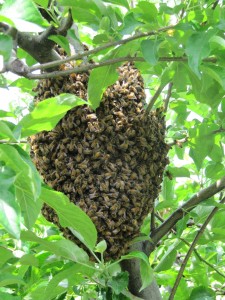 Beekeeping is proving itself an urban hobby, with hives popping up on rooftops, in backyards, and in community gardens throughout New York City. Even the Botanical Garden has two hives in the Ruth Rea Howell Family Garden.
Beekeeping is proving itself an urban hobby, with hives popping up on rooftops, in backyards, and in community gardens throughout New York City. Even the Botanical Garden has two hives in the Ruth Rea Howell Family Garden.
As a Bronx beekeeper myself, I regularly marvel at the detailed work of the colony: the bright colors of pollen brought back from so many flights, the hoarded honey, and the careful nursing of new life in the brood chamber.
The urban honeybee has faired well this summer, with ample sunshine, and in turn, abundant blooms of plants such as mountain mint (Pycnanthemum virginianum). The leaves of this native perennial make a good tea or can be applied as mosquito repellant. Butterfly bush (Buddlea davidii), a shrub that can tolerate urban pollution and alkaline soils, has tufts of tiny purple flowers on show for months—a perfect plant for pollinators. These and many other flowering plants, from vegetables and herbs to street trees, are visited by bees and other pollinators in great numbers every season.
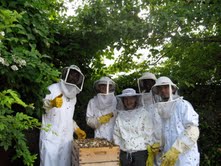 One Bronx beekeeper who keeps hives behind a rectory abutting the Genesis Park Community Garden has harvested 275 pounds of honey since July. It tastes floral, minty, and may originate in good part from the nectar of white clover, a spring bloomer found on lawns and other open spaces in the city.
One Bronx beekeeper who keeps hives behind a rectory abutting the Genesis Park Community Garden has harvested 275 pounds of honey since July. It tastes floral, minty, and may originate in good part from the nectar of white clover, a spring bloomer found on lawns and other open spaces in the city.
Read More
Posted in Learning Experiences, Wildlife on August 19 2010, by Plant Talk
See Honey Taken from Hive Saturday as Part of National Celebration
 |
Toby Adams is Manager of the Ruth Rea Howell Family Garden. |
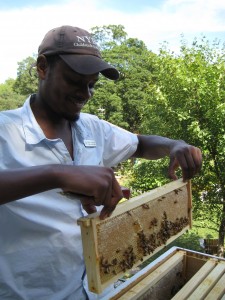 Every day during the gardening season, the Family Garden is a hive of activity hours before visitors arrive. A diverse staff—coordinators, instructors, explainers, volunteers, and interns—zip about this way and that, preparing for the day’s programs. I’ve described this scene as resembling a beehive—the many tasks to be accomplished are shared by everyone, with necessary details divided and completed.
Every day during the gardening season, the Family Garden is a hive of activity hours before visitors arrive. A diverse staff—coordinators, instructors, explainers, volunteers, and interns—zip about this way and that, preparing for the day’s programs. I’ve described this scene as resembling a beehive—the many tasks to be accomplished are shared by everyone, with necessary details divided and completed.
Veteran staff mentor new arrivals in how to get tiny seeds and delicate plantings off to a good start. Difficult projects are completed through teamwork and cooperation, and the most unglamorous but important of chores (cleaning the tools and washing the dirty dishes) taken on by a willing hand for the benefit of the group.
I’ve come to realize that this analogy to a beehive is most appropriate. Since May 1, I’ve had the awesome opportunity to witness the activity of a real beehive while helping to manage our newest addition to the Family Garden—two honeybee hives placed on top of our garage.
Read More
 We introduced our first pair of beehives to the Ruth Rea Howell Family Garden in 2010, the year beekeeping was re-legalized in New York City. We sited the apiaries—Langstroth hives—atop the single flat rooftop on our garden site, a one-story brick and concrete building home to both gardening and office equipment fondly called “the tool shed.” This gave our foraging worker bees zipping in and out of the hive a clear flight path above our vegetable plots, above and away from our visitors.
We introduced our first pair of beehives to the Ruth Rea Howell Family Garden in 2010, the year beekeeping was re-legalized in New York City. We sited the apiaries—Langstroth hives—atop the single flat rooftop on our garden site, a one-story brick and concrete building home to both gardening and office equipment fondly called “the tool shed.” This gave our foraging worker bees zipping in and out of the hive a clear flight path above our vegetable plots, above and away from our visitors. 
 So you don’t have a back yard, a rooftop apartment in Brooklyn, or even a couple of bee suits and a smoking can. Not a problem! For kids (or parents!) who are bursting with questions over the city’s biggest agricultural excitement since fire escapes first met tomato plants, you won’t need any of the above to pick up the basics.
So you don’t have a back yard, a rooftop apartment in Brooklyn, or even a couple of bee suits and a smoking can. Not a problem! For kids (or parents!) who are bursting with questions over the city’s biggest agricultural excitement since fire escapes first met tomato plants, you won’t need any of the above to pick up the basics.





